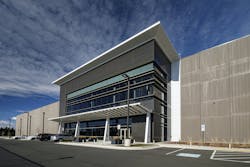Workload Reality Check: Enterprise Colocation is in High Demand
In this edition of Voices of the Industry, John Day, Vice President of Leasing at Sabey Data Centers, explores why enterprise colocation at data centers will not be rendered extinct by the cloud.
John Day, Vice President, Leasing at Sabey Data Center Properties
The cloud is a phenomenal platform for many use cases. It has made it easier for small and new businesses to leverage advanced network, compute, and storage resources beyond their means to purchase in a dedicated model. Large companies, too, have requirements well-suited to the cloud; that is, on-demand, scalable resources for applications and workloads with dynamic, fluid demand curves.
For years, there has been an expectation that the cloud would gobble up all enterprise workloads and meet all enterprise infrastructure requirements. Top results of a quick internet search on “the cloud will eat the world” include Forbes in 2012 (“The Cloud is Eating the World”), Data Center Knowledge in 2016 (“Cloud Services are Eating the World”), and ZDnet in 2018 (“Cloud Computing is Eating the World”). Even major analyst organizations have proclaimed that “the data center is dead.”
But is this happening?
Besides the reality that the cloud lives in the data center so it cannot render the data center extinct, this speculation overestimated the cloud’s ability to meet all the complex, multi-layered requirements that enterprises have – and will continue to have.
There’s no doubt the cloud operators are the primary driver of growth in the data center industry in absolute MW absorption. In Northern Virginia, my home base, cloud service providers drove most of the 323MW of absorption in 2020 (JLL). My company, Sabey Data Centers, has realized significant growth in working with public cloud providers.
However, many enterprises discovered—and increasingly understand—that they have workloads that either aren’t optimized or are very pricey on cloud platforms. This realization has ensured an ongoing, healthy market for enterprises seeking data center services.
The very first “Key Finding” listed in the Uptime Institute’s “Global Data Center Survey” from 2020 is: “The enterprise data center is neither dead nor dying. The switch of critical loads to a public cloud is happening slowly, with more than half of workloads expected to remain in on-premises data centers in 2022.” Structure Research projects continued “steady as she goes” growth in the global enterprise colocation market from $6.6 billion in 2021 to $7.2 billion in 2024. DataCenterHawk recently estimated that 25% of current U.S. demand is enterprise-driven, with more than a dozen deals of a megawatt or more in play this quarter.
Cloud works exceptionally well for edge cases such as public-facing, latency-sensitive, or media delivery applications such as gaming, advertising technology, and retail. However, costs often skyrocket when an end user’s consumable compute forecasts are inadequate.
This experience has led many enterprises to undertake massive cloud repatriation initiatives, pulling workloads back out of the cloud. Uptime Institute’s 2020 data center survey revealed that 30% of respondents had moved workloads back from a public cloud to a private cloud or traditional data center environment. Reasons most commonly cited include costs, regulatory compliance, performance issues, and security concerns.
Even those who can benefit from the cloud are still engaged in hybrid computing, a blend of cloud and their own infrastructure.
As a result, nearly all enterprises keep a significant portion of their applications and workloads in their own data centers. Fifty-two percent of respondents to the same survey reported, “we don’t place mission-critical workloads into public clouds and have no plans to do so.”
In some cases, “their own data centers” refer to on-premise facilities. More often, it refers to third-party, multi-tenant data centers, continuing a shift that has been underway for years.
Building and managing data center facilities is rarely feasible for a modern enterprise, resistant as most are to keeping excess real estate on their books. Outsourcing this critical real estate function has bolstered the multi-tenant data center market for many years, mirroring the overwhelming trend across most industries to outsource technology in general.
Additionally, many enterprise workloads remain in aging and inefficient company-owned data centers. Built out of necessity before the advent of the third-party data center industry, many on-premises data centers are now over two decades into an expected 15-year useful lifespan. With untold MWs of compute capacity languishing in legacy on-premise data centers, many large corporations possess workloads that would benefit from the higher efficiencies and densities of modern facilities.
Additionally, nearly every metro area has significant company-owned stranded capacity due to growth that never occurred, M&A activity, or transitioning of public-facing workloads to the cloud. Atlanta, Philadelphia, New Jersey, New York, Connecticut, Chicago; all have significant amounts of privately-owned data center inventory with no real solution for the next generation of the life of these facilities.
Between the aging inventory of corporate data centers and the data and application requirements unfit for the cloud, enterprise sales and leasing opportunities for multi-tenant data center providers will remain strong. The flexibility of technical design, financial terms, and ramp schedules, no real estate ownership, and the benefits of a modern facility combine for a straightforward business decision. Further, a cage or suite provides the security, privacy, and control of a company=owned data center without the drawbacks of massive capital investment. Other costs such as maintenance, data center operations, and security are shared fractionally.
That has spurred the growth of an entire industry of data center providers—some in single markets, others in multiple markets like Sabey—enabling bi-coastal data center strategies that are an essential part of a hybrid computing approach.
John D. Day is Vice President of Sales and Leasing with Sabey Data Centers. He has been involved with the data center industry for 20 years as a sales and leasing executive and a mergers-and-acquisitions investment banker. He is based in Northern Virginia.


